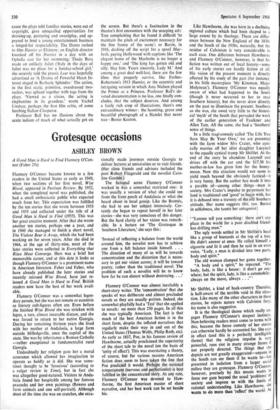Mad blood
PENELOPE HOUSTON
Horror Movies: an Illustrated Survey. Carlos Chirens (Seeker and Warburg 63s) Shakespeare on Silent Film Robert Hamilton Ball (Allen and Unwin 63s) There are several ways of writing about horror movies, and most of them do their cause no good whatsoever. Most irritating, perhaps, by a short head, is in-group vociferousness, with its doting catalogues of fiends we have known. But right behind come the resolute Freudians, refusing any vampire its right to an indepen- dent existence; and, of course, the reproachful moralists, gloomily detailing the more sadistic episodes, and ready to blame horror movies (along with comic-strips, pop-songs and a few other hetes noires) for everything from student unrest to the crime statistics.
A great virtue of Carlos Clarens's Horror Movies is the exemplary good sense with which it dodges such pitfalls. As far as theory goes, Mr Clarens takes up an orderly and entirely defensible position: the taste for fear, or the imagination of catastrophe, remains a per- manent factor of human make-up; and what's interesting is not so much psychoanalytical tinkering with the works of terror, as the forms that its apparatus takes at various times. Why, for instance, should there have been a short, sharp vogue for zombie movies? Why could the cinema never make much headway with werewolves? Why, in fact, is the basic reper- tory so limited that horror cinema, and for that matter horror fiction, remains true down the years to Dracula, Frankenstein, Jekyll and Hyde, along with assorted mad scientists, vam- pires, warlocks and the occasional Phantom of the Opera?
The borders of horror cross those of science fiction, where all the monsters have run mad and Godzilla and his kind are permanently on the rampage, or where more sinister and less demonstrative 'things' are quietly moving (as in Invasion of the Body Snatchers) to obliterate human intelligence. All the same, this is the area of the impersonal. Classic horror is a quieter and more suggestive business, depend- ing not on tidal waves engulfing Wall Street, or Technicolor close-ups of vampires at play, but a certain audience complicity in the subtler art of fear. The cinema's urge to show is destructive of true horror. So, of course, is the loss of innocence on both sides of the camera: the corroding sophistication that forces so many forms of popular entertainment into the dead-end of self-parody, because everyone has become too knowing or too afraid of naivete to take it straight.
In fact, horror film-making has always had its own subterranean poetry, alongside its own recognition of the absurd: an area of macabre sensibility happily remote from pressures of `taste,' literary respectability or the desire to impress the critics. Mr Clarens's compact, en- thusiastic and very entertaining book moves, if anything, too swiftly, but it covers a lot of territory, all the way from Fritz Lang's night- mares of the days before Hitler, to the maddest mad scientist crossly remonstrating with his creation: You have a civil tongue in your head. -I know, I sewed. it in there'; or from the extraordinary. Bela Lugosi ('I am . . . Dracula') to Lon Chaney submitting to the appallingly painful demands of his monster make-up.
Professor Ball's book about what the silent screen did to Shakespeare is also very likeable, thanks partly to an engagingly obsessional quality which suggests that a relatively minor academic investigation somehow ramified into a compulsive quest. The index lists sixteen Othellos, twenty-one Hamlets, over sixteen Romeo and billets (not to mention Roping Her Romeo, Othello in Jonesville. Romeo in Pajamas and other less Shakespearian titles). Many of the films have been deservedly lost for ever; or survive only in mutilated and almost unviewable form; or have to be tracked through the florid and unhelpful language of pre-1914 catalogues. The dust had settled thick on this particular corner of the archives; but it was worth disturbing.
Early film-makers turned to Shakespeare be- cause the plays told familiar stories, were out of copyright, gave unequalled opportunities for dressing-up, posturing and swordplay, and ap- peared to lend a young entertainment business a longed-for respectability. The Danes rushed to film Hamlet at Elsinore; an English director knocked off his Hamlet in a day with an Ophelia cast for her swimming; Theda Bara made an unlikely Juliet (Italy in the days of Juliet was no place for a Sunday-school girl,' she severely told the press); Lear was hopefully advertised as 'A Drama of Powerful Heart In- terest staged in Barbaric Splendor.' The action, in the first static, primitive, overdressed two- reelers, was spliced together with tags from the plays. 'Viewed as a circus, the acting is elephantine in its grandeur,' wrote Vachel Lindsay, perhaps the first film critic, of some lurching Italian Cleopatra.
Professor Ball has no illusions about the acute tedium of much of what actually got on the screen. BM there's a fascination in the theatre's first encounters with the usurping art: Tree complaining that he found it difficult 'to maintain the pitch of excitement necessary for the fine frenzy of the scene'; or Barrie, in 1916, dashing off the script for a spoof Mac- beth, guying Hollywood with captions like 'The elegant home of the Macbeths is no longer a happy one,' and 'The king has gotten old and silly. Slay him. Yours sincerely, Lady M.' And among a great deal well-lost, there are the few films that properly survive, like Forbes- Robertson's 1913 Hamlet, or the eccentric and intriguing version in which Asta Nielsen played the Prince as a Princess. Professor Ball's de- voted documentation is no less, one finally con- cludes, that the subject deserves. And among a fairly rich crop of illustrations, there's one extraordinary winner: the haunting, grave and beautiful photograph of a Hamlet that never was—Buster Keaton.







































 Previous page
Previous page